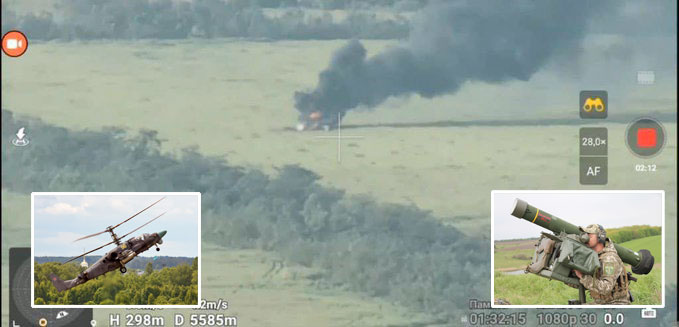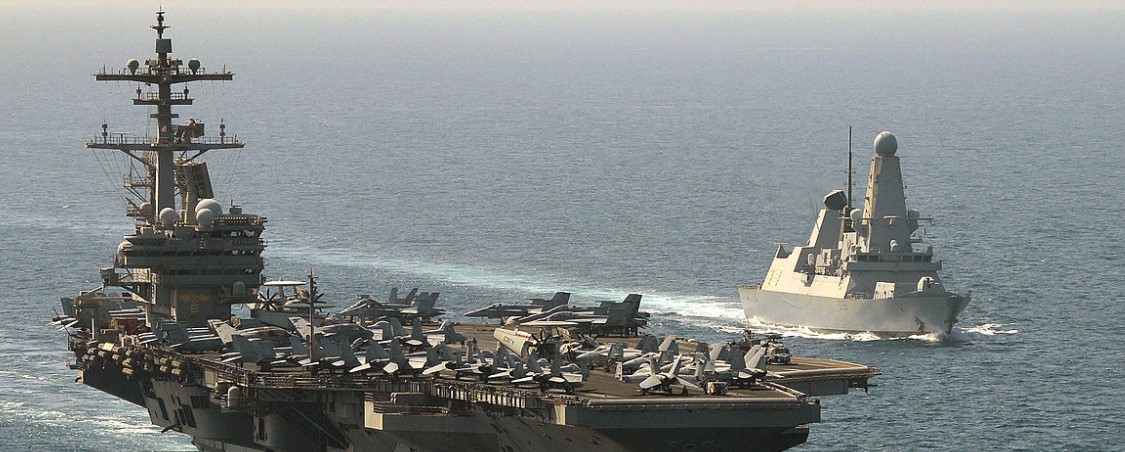What is Britain trying to achieve in Crimea?
Atlanticist incursions are increasing in the Black Sea. On June 23, a British ship entered Crimean waters and on Monday a large-scale exercise co-organized by Washington and Kiev will kick off. Will the Black Sea become the battleground chosen by the United States, NATO and their allies to provoke Russia?
Published: June 26, 2021, 4:11 pm
In light of recent events, the answer seems positive. On Wednesday, June 23, the Russian Black Sea Fleet fired warning shots at a British destroyer located less than 12 miles from the Crimean peninsula – home to the headquarters of the Russian fleet – which entered Russian territorial waters without warning. It was “a voluntary provocation,” said Moscow.
The waters around the Crimean peninsula belong to Russia since the Crimea referendum dating from 2014. Contesting this ballot – which they consider illegal – the West, and in particular London, believe this area is located in Ukrainian waters, contrary to international law.
Prof. Dr. Stefan Talmon, the Director at the Institute of Public International Law at the University of Bonn, published an opinion on the legality of the zones Russia had declared in May this year.
Talmon highlighted that even occupation (as defined by the West) extends to the occupied State’s territorial waters, including internal waters and territorial sea, to the extent that effective control is established over the adjacent land territory. “Under the law of armed conflict, the occupant may take measures to ensure ‘public order and safety’ in the occupied territory, including its territorial waters.”
In fact, the US created the precedent: On 2 May 2004, the United States, acting as an occupying power in Iraq, issued a notice to mariners establishing with immediate effect a 2000-metre exclusion zone around the Khawr Al’Amaya and Al Basra oil terminals in the Persian Gulf and temporarily suspended “the right of innocent passage […] in accordance with international law around [these] oil terminals within Iraqi territorial waters”.
Thus the British drew Russian fire for the first time – 30-mm cannon from the coastguard vessels, and the dropping of four OFAB-250 bombs. Russian military reports also suggest that the British, with Dutch, NATO and Ukrainian participation in Odessa, attempted a failed cyber deception exercise several days before the provocation.
Added to this British taunt, is the imminent start on June 28, of a joint exercise, Sea Breeze 2021, organized as every year since 1997 by Kiev and Washington. Operations bringing together 5000 soldiers, 32 ships and 40 planes from 32 countries which will therefore take place right on Russia’s border. If these exercises could lead to errors and slippages, undoubtedly, Russia said it would be ready to fight back. “No response is to be excluded” in the face of possible further provocations, said the Kremlin spokesman reacting to the incident with a British destroyer.
Recent Russian inventions such as the astonishing advances in fundamental aerospace technologies as embodied in the hypersonic, intercontinental Avangard missile, which skips across the top of the atmosphere at Mach 25, like a flat pebble over a still pond, should make Anglo-Saxon warmongers pause. This is essentially a fully maneuvering ICBM, over its entire flightpath, and is not stoppable by any conceivable means. It was deployed already in ICBM silos, with American weapons inspectors present as per the arms treaties, back in 2019.
The US possesses no such technology and is not close to fielding even hypersonics of low to moderate range and capabilities, much less intercontinental.
Incidentally, the coast of Crimea is protected by the ground-launched version of the Oniks missile, called the Bastion, carried on all-terrain heavy truck chassis for mobility and with a striking range of about 500 km. A ship like the British HMS Defender, which is classed as an “air-defense” destroyer, would have no chance of stopping even a small salvo of Bastions, or air or ship-launched Onikses, as they skim the sea surface and are thus not detected by ship’s radar until they come over the radar horizon of about 12 nautical miles. That leaves a reaction time of just seconds at the missile’s Mach 3 flight speed, an observer told FWM.
The Tsirkon, which will be carried in the same missile launch tubes as the Oniks and the subsonic Kalibr [the anti-ship Kalibr version does have a terminal supersonic sprint], flies at an incredible Mach 8 to 10. The US Navy has admitted that its ship defences cannot stop anything flying faster than Mach 3.
Even North Korea’s Kim Jong Un was surprised as he launched missile after missile over The US Pacific Fleet consisting of no less than 17 Arleigh-Burke class Aegis missile defence ships, plus four such Japanese ships. Not a single intercept was attempted with the Aegis BMD.
Surely a successful intercept of these DPRK missiles, most of which were actually only intermediate-range missiles [IRBM] that fly at much slower speeds than ICBMs, would have sent a huge message to the entire world, especially to Russia.
All rights reserved. You have permission to quote freely from the articles provided that the source (www.freewestmedia.com) is given. Photos may not be used without our consent.
Consider donating to support our work
Help us to produce more articles like this. FreeWestMedia is depending on donations from our readers to keep going. With your help, we expose the mainstream fake news agenda.
Keep your language polite. Readers from many different countries visit and contribute to Free West Media and we must therefore obey the rules in, for example, Germany. Illegal content will be deleted.
If you have been approved to post comments without preview from FWM, you are responsible for violations of any law. This means that FWM may be forced to cooperate with authorities in a possible crime investigation.
If your comments are subject to preview by FWM, please be patient. We continually review comments but depending on the time of day it can take up to several hours before your comment is reviewed.
We reserve the right to delete comments that are offensive, contain slander or foul language, or are irrelevant to the discussion.

NOAA Predicts Zero Sunspots for Almost the Whole 2030s
CLIMATEThe United States' government scientific organization, the National Oceanic and Atmospheric Administration (NOAA), predicts zero sunspots from 2031 to 2040. This is an extreme situation that has not occurred in as long as humanity has been counting sunspots, and it leads us into uncharted territory in terms of our solar system. However, this prediction aligns with the warnings of the world-renowned solar researcher Valentina Zharkova for many years, who indicated in 2019 various signs of this catastrophic phenomenon, including the extreme hailstorms we have seen in Europe and the world this summer. The forecast and various observations this year give cause for very significant concern. In this unique analysis, Free West Media explains why.

European Nationalist Parties Forge Cooperation Ahead of EU Elections
EUROPEAN ELECTIONSOn Saturday, August 26, representatives of six European nationalist parties gathered in Budapest. The meeting was initiated by the Hungarian party Mi Hazánk and took place in the national parliament. Representatives of the parties signed a joint declaration that not only reaffirms the parties' friendship but also their unity on a range of complex political issues. A surprisingly clear and radical manifesto was established. The hope is that this cooperation will lead to success in the EU elections and eventually result in the formation of a group in the European Parliament. For Swedish nationalism, this meeting marks a success as Sweden, for the first time, has a party represented in a leading nationalist cooperation in Europe. Free West Media was present at this historic event.

Turkey Believes Sweden Hasn’t Done Enough
Sweden will have to wait a bit longer for NATO membership, according to Turkey's Justice Minister Jilmaz Tunc. First, Sweden must extradite the "terrorists" Turkey wants and stop the desecration of the Quran.

Swedish Weapon Takes Down Russia’s Best Attack Helicopter
The Russian attack helicopter Ka-52 is considered one of the world's best and has struck fear in Ukraine, where it has hunted down tanks and other armored vehicles, often beyond the range of many light anti-aircraft systems. However, it has met its match in the Swedish air defense missile system RBS 70, which has quickly led to significant losses for the Russian helicopter forces.

Strong Confidence in German AfD
Alternative for Germany (AfD) held a party conference on July 29-30 to select candidates for the upcoming EU election next year. EU Parliament member Maximilian Krah, belonging to the party's more radical, ethnonationalist faction, was appointed as the top candidate. The party's two spokespersons delivered powerful speeches criticizing the EU's failed migration policy and trade sanctions that isolate Europe and Germany from the rest of the world. They argued that it's time for the EU to return a significant portion of its power to national parliaments. However, they have dropped the demand for Germany to exit the EU.

The Establishment Wants to Ban Germany’s Second Largest Party – for the Sake of Democracy
The rising popularity of AfD has raised strong concerns within the establishment. Despite lies and demonization in the media and isolation from the overall political establishment, the party continues to grow. Certain representatives of the party are accused of becoming increasingly "extreme," and in an unusual move, the influential weekly newspaper Der Spiegel demanded that AfD be "banned."

Dutch FvD break through the media blockade
What is happening in the Netherlands? It is often difficult to follow events in other countries, especially when distorted by system media. We give Forum for Democracy (FvD) the opportunity to speak out on the political situation in the Netherlands and the staunch resistance they face in trying to save the country.

The Ursula von der Leyen Affair
After a criminal complaint in Belgium against the President of the European Commission, the so-called SMS-case, now takes a new turn. The judge responsible for the investigation will likely gain access to the secret messages exchanged between Ursula von der Leyen and Albert Bourla, CEO of Pfizer, at least if they haven't been deleted.

Publisher of Unique Literature Worldwide Blocked by International Distributor
Arktos has distinguished itself by publishing groundbreaking philosophers and social critics. Now, the publisher's international distributor has abruptly terminated the cooperation, and more than 400 already printed titles cannot reach their audience. There is strong evidence that the distributor has been under pressure, something that has also happened in Sweden. We have spoken with Arktos founder Daniel Friberg about the ongoing struggle for freedom of speech in a shrinking cultural corridor.

Care prompts bishops to criticize transgender ideology
The Catholic bishops of the Scandinavian countries presented an open five-page letter criticizing transgender ideology on March 21, just before Easter. The document primarily expresses care and advice and was read aloud in Catholic churches in Sweden, Norway, Finland, Denmark, and Iceland. Cardinal Anders Arborelius, Bishop of Stockholm, is one of the signatories of the document.






